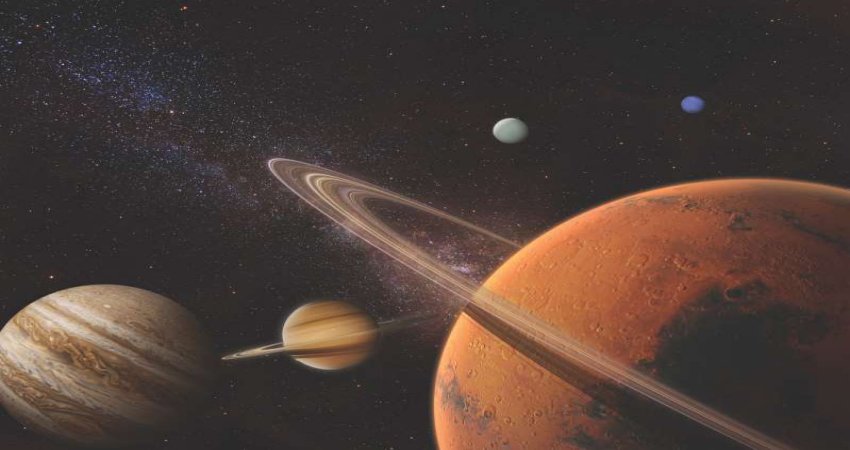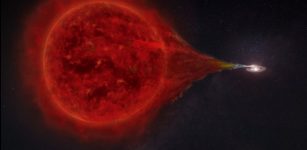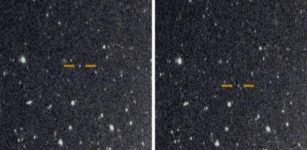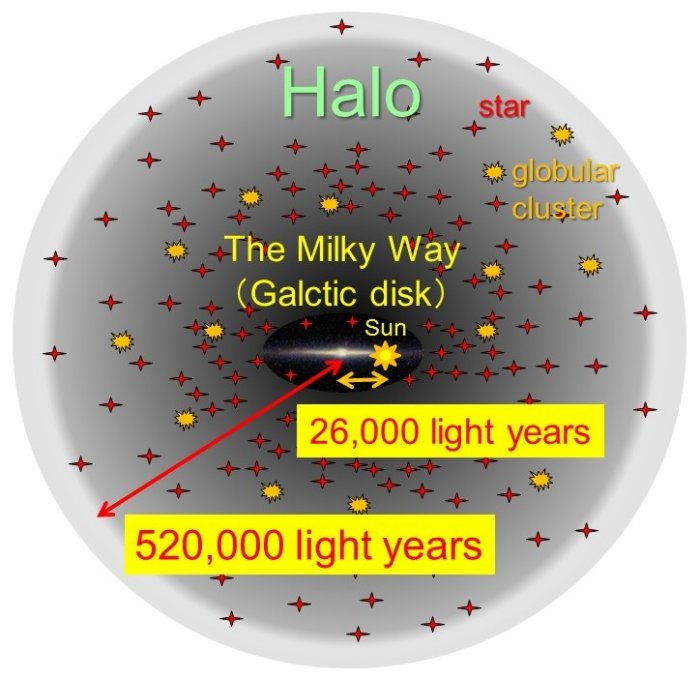Most Distant Periphery Of The Milky Way – Identified
Eddie Gonzales Jr. – MessageToEagle.com – The utmost edge of the Milky Way galaxy has been identified by researchers using the Subaru Telescope’s Hyper Suprime-Cam (HSC) digital camera .
The ultimate size of the galaxy is 520,000 light years in radius, 20 times larger than the distance between the galactic center and our solar system (26,000 light years) (Figure 1).
Stars that reach these outermost regions of the galaxy during their orbital motions are ancient stellar populations with ages as old as 12 billion years.
The spatial extent in which these ancient stars wander is, therefore, important for understanding the Milky Way’s formation.
The galaxy holds a widely extended halo component, in addition to the bright Milky Way in the form of the stellar disk component.
The halo comprises approx. 1 billion ancient stars and 150 globular clusters with ages as old as 12 billion years (Figure 1). The halo thus contains the remnants of long-lived stars and star clusters that formed in the first stage of the galaxy.
This suggests that the galaxy was quite large in its beginning before the later formation of the younger, disk component.
Investigating the expanse of this halo component in the galaxy is comparable to identifying the outer boundary of a forest from inside the forest and observing the trees.
The team of researchers led by Tohoku University graduate student Tetsuya Fukushima and his supervisor Masashi Chiba derived the spatial density of the so-called Blue Horizontal Branch (BHB) stars over the galaxy halo.
While this density generally decreases the further you go from the galactic center, the team discovered a sharp drop in density at around 520,000 light years away from the galactic center.
As a result, the team had finally observed the outermost edge of the galaxy. This is about 20 times larger than the distance between our solar system and the galaxy center.
Our neighbor, the Andromeda galaxy, is reported to have an extended halo component as large as 538,000 (at the very least) light years in radius. It is, therefore, systematically larger when compared to the galaxy halo.
Further mapping of this ancient component of the galaxyis planned.
Written by Eddie Gonzales Jr. – MessageToEagle.com Staff
Related Posts
-
 Iconic Tombaugh Regio Structure Controls Winds On Pluto
No Comments | Feb 5, 2020
Iconic Tombaugh Regio Structure Controls Winds On Pluto
No Comments | Feb 5, 2020 -
 Web Of Cosmic Dark Matter Has Been Identified In The Coma Cluster
No Comments | Feb 9, 2024
Web Of Cosmic Dark Matter Has Been Identified In The Coma Cluster
No Comments | Feb 9, 2024 -
 Martian Moon Deimos Reveals A Big Secret
No Comments | Jun 10, 2020
Martian Moon Deimos Reveals A Big Secret
No Comments | Jun 10, 2020 -
 Nova Explosion Observed By Magic Telescopes
No Comments | Apr 14, 2022
Nova Explosion Observed By Magic Telescopes
No Comments | Apr 14, 2022 -
 Did Venus Ever Have Oceans? – New Study
No Comments | Oct 14, 2021
Did Venus Ever Have Oceans? – New Study
No Comments | Oct 14, 2021 -
 NASA’s Curiosity Rover Departs Mars’ Vera Rubin Ridge And Moves To Next Destination
No Comments | Feb 11, 2019
NASA’s Curiosity Rover Departs Mars’ Vera Rubin Ridge And Moves To Next Destination
No Comments | Feb 11, 2019 -
 M87 Black Hole Is Propelling Particles At Speeds Greater Than 99% Speed Of Light
No Comments | Jan 8, 2020
M87 Black Hole Is Propelling Particles At Speeds Greater Than 99% Speed Of Light
No Comments | Jan 8, 2020 -
 Discovery Of 20 New Moons Orbiting Saturn
No Comments | Oct 8, 2019
Discovery Of 20 New Moons Orbiting Saturn
No Comments | Oct 8, 2019 -
 A Planet The Size Of Mars But With The Makeup Of Mercury – Discovered By TESS
No Comments | Dec 3, 2021
A Planet The Size Of Mars But With The Makeup Of Mercury – Discovered By TESS
No Comments | Dec 3, 2021 -
 Critical Clue About The Life Cycles Of Binary Stars – Detected
No Comments | Jul 7, 2022
Critical Clue About The Life Cycles Of Binary Stars – Detected
No Comments | Jul 7, 2022

